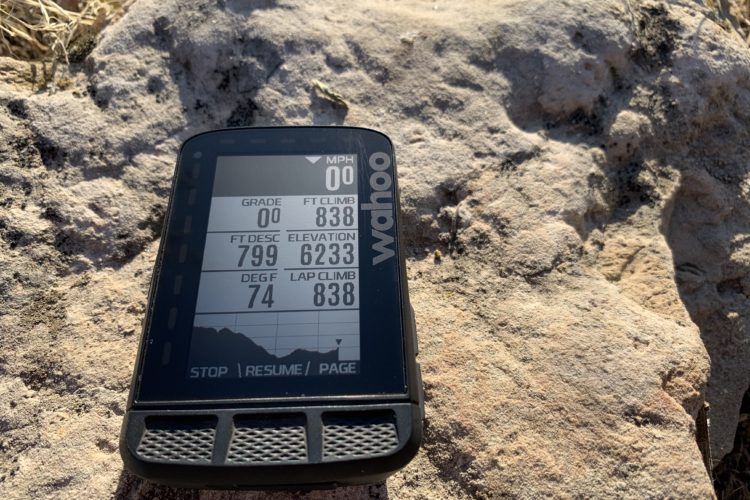
The Bryton Rider 750 is a fully-featured and connected GPS designed for cycling that boasts a color touchscreen and more options than any rider could possibly exhaust in a season. Here’s what I’ve learned after testing the device over the past few weeks.
Form factor
Like other cycling GPS units in this category, the Bryton Rider 750 features a 240×400 pixel color display, which is about three inches measured diagonally. My test unit weighs 94.4g which is within a gram (!) of the claimed weight of the Wahoo Elemnt Roam and more than 20g lighter than the Garmin Edge Explore.
Also like the Garmin and Wahoo units, Bryton uses a quarter-turn mount system, and the included bar mount uses simple, stretchy bands to quickly attach to any cockpit. I run 35mm-diameter bars, and the Bryton mounts worked right out of the box.

The GPS unit has four physical buttons and a touchscreen. The buttons are easy to master — there’s a dedicated button to start/stop the ride, and another to switch screens — and they are easily-accessible on the bike with a good glove feel. The touchscreen works surprisingly well with gloved fingers as well.
Bryton says the unit is IPX7 waterproof-rated, exactly like the Wahoo and Garmin units in this class. The Rider 750 claims a 20-hour battery life on a single charge which is at least three hours more than either of the comparison units.
Sensors and wireless options
Looking at the spec sheet for the Bryton Rider 750, it’s clear the company places a premium on accuracy — or at least taking in as much data as possible. In addition to the barometric altimeter used to collect more accurate elevation data, the unit also receives signals from multiple satellite positioning constellations: GPS, Glonass, Galileo, Beidou, and QZSS.
Wireless capabilities include Bluetooth, wi-fi, and ANT+ for compatibility with a raft of devices including smartphones, heart rate monitors, smart trainers, speed sensors, radar systems, e-bikes, and wireless shifters. The Rider 750 can be purchased as a standalone GPS unit ($269, available at Walmart.com and Amazon), or in a bundle ($349 at Walmart.com) that includes heart rate, speed, and cadence sensors.
On the screen and on the trail
Many of the settings for the Bryton Rider 750 can be adjusted using the free smartphone companion app. The device stores up to three bike profiles for those who plan to swap the unit between different types of bikes. Each bike can be configured to show different data screens; for example, power for when you’re riding the road bike, and max speed for the enduro bike. I set my test unit up with just two data screens — the map and a summary of my speed/distance/elevation/time of day — to minimize toggling to see the info I need during the ride.
Open Street Map data is used for the included base maps, and there are trails shown for many areas. Orienting to the map that’s displayed on the GPS can be tricky because most road names are not visible on the GPS. And unlike most cycling GPS units I’ve used, there isn’t a breadcrumb showing where you’ve been so far. Personally, I rely on those breadcrumbs to help me backtrack when it’s time to go home or to confirm that yes, I have been to this intersection once before and I’m not just imagining things. Perhaps a future firmware update will add this important feature.
Some functions on the GPS can feel a little laggy, as if using an under-powered computer, but ultimately I’ve found its operation to be reliable on the trail. The backlight is handy for night riding and the screen has the right amount of contrast to remain highly visible in most light conditions.
One unique feature Bryton includes with the Rider 750 is the ability to navigate using your voice*. The asterisk on that statement is to note that you actually need to be connected to your smartphone, and said smartphone must be connected to the internet. Oh, and really the voice stuff just saves you the hassle of typing in the name of your destination. Siri does this too, but if you’re buying a dedicated GPS for biking you’re probably not mounting your phone to your bars so I guess it’s useful in a way. But you’ll still need to carry the phone along somewhere.
It’s also possible to navigate to any point you choose on the screen with turn-by-turn directions. This feature appears to rely on a smartphone internet connection as well.
For truly offline navigation, GPX trail routes can be loaded using the smartphone app. The process is a little wonky, but basically you download a GPX trail file from a website like Singletracks and email it to yourself. From the email app on your phone, you can then send the attachment to the Bryton smartphone app. Finally, you’ll need to send the route from the app to the device. Doing the same with Wahoo and Garmin devices is a bit smoother in that you can just click a GPX file link in your mobile browser and send it directly to the respective apps, which then automatically push data onto the device without the extra step of emailing the file and clicking to send to the GPS.
A slightly easier route for getting routes onto the Rider 750 is to connect a Strava account. Any routes saved to your Strava profile are automatically available in the Bryton app, but again, you’ll need to remember to tell the app to send the route to the device. A connected Strava account does automatically receive trip data at the end of each ride which is an important feature for many mountain bikers. Bryton offers connections to other services as well including Komoot and Ride with GPS.
Who it’s for
Priced at $269, the Bryton Rider 750 isn’t the cheapest color, touchscreen cycling GPS on the market. Rather, the Rider 750 distinguishes itself through a smorgasboard of software features like voice navigation and the ability to use it with anything from an e-bike to a smart trainer. Geeks will enjoy geeking out over the features, while those who can’t technology may prefer a simpler device.
⭐️ Find the Bryton Rider 750 at Walmart.com and Amazon.

























0 Comments